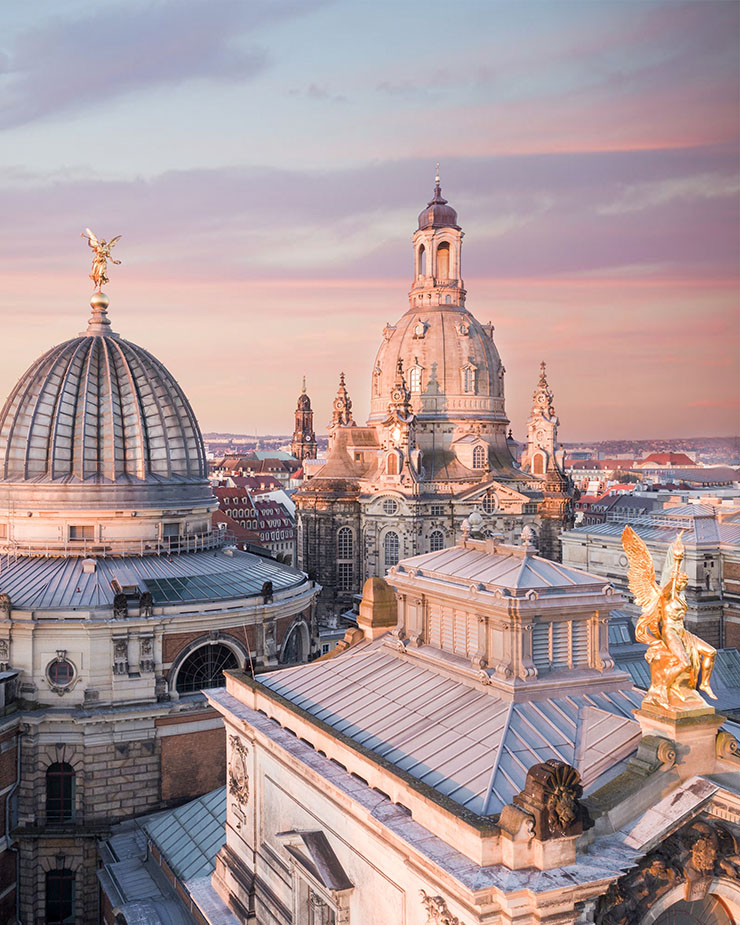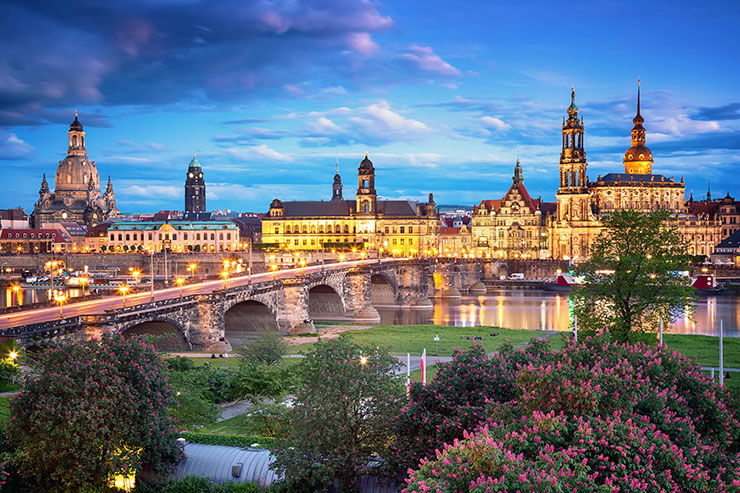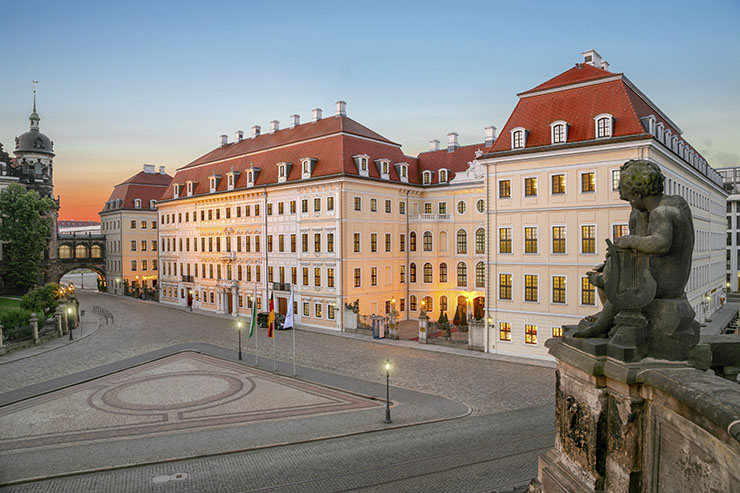
WORDS TOBY TANNAS
Restoration began in the 1990s. Skilled tradesmen were tasked with recreating intricate details of the 800-year-old city’s baroque and rococo architecture.
It’s not often a honeymoon can eclipse a wedding, but in the case of our recent nuptials in Germany, our honeymoon with Kempinski Hotels was one of the best decisions we made.
European hotels, the best ones, are known for their charm and attention to detail. Kempinski has all of the finer points mastered. Their hotels exude luxury and exceptional service from the moment you arrive.
A day after we said our vows in the German countryside, we arrived on the red carpet of Berlin’s Adlon Hotel. At the doorstep of the historic Brandenburg Gate, this iconic hotel is the epitome of luxury. From the caped bellmen to the luxurious lobby lounge, the Adlon evokes the feeling that you’ve arrived. It’s both grand and gracious at the same time.
The original Adlon Hotel opened in 1907 and became one of the most famous hotels in all of Europe. It was mostly destroyed at the end of WWII. Today, it is a new building inspired by the original design and no detail has been overlooked. It offers beautiful suites and extremely comfortable beds and linens, the spa is divine and the location in the heart of Berlin can’t be beat.
After two unforgettable days, we sadly checked out of the Adlon. It is the kind of place you never want to leave, but another adventure was calling. We were heading east for a continuation of our Kempinski experience in Dresden Elbland.
You may know Dresden as the city destroyed by Allied bombs near the end of WWII. More specifically, it was the Dresden city centre that was flattened. It is just a small area but it is packed with centuries of history and architecture. All of it was destroyed in the bombing raids and it would remain in that state for nearly half a century.
Restoration began in the 1990s. Skilled tradesmen were tasked with recreating intricate details of the 800-year-old city’s baroque and rococo architecture. Dresden today is an attractive destination for anyone who loves history, culture and cuisine.

Known as the “Florence on the Elbe” (river), Dresden is like a postcard at every turn. The first glimpse of our hotel, the Taschenbergpalais Kempinski, took my breath away. Built in the 18th century by order of the Saxon monarch Augustus the Strong for his favourite mistress Anna Constantia, Countess von Cosel, it exudes opulence. The building was among those destroyed in 1945. It was restored in 1995 and today is both beautifully historic and comfortably contemporary at the same time.
Boasting 213 elegant rooms and luxurious suites, the Taschenbergpalais Kempinski does not fall short on service or charm. The rooms are spacious and contemporary with impressive views right outside the large windows. Staff are warm, helpful and knowledgeable. It’s a first-class experience that feels special.

With so many tempting restaurant options in the immediate vicinity, we took advantage of the hotel concierge service. They enthusiastically provided several recommendations, and we opted for modern German cuisine just a short walk away.
As we headed off into the night we were sidetracked by the stunning architecture. Under the lights of the city, the buildings seemed to come to life. The famous Semper Opera House and Dresden Cathedral called to our cameras. (We did eventually make it to dinner and it was delicious.)
We booked a private walking tour of Dresden for the following morning, and this is something we highly recommend. Dr. Alexander Klein met us in the Taschenbergpalais lobby. Just a few steps from the hotel we were already immersed in the Saxon capital’s history. Dr. Klein’s knowledge and obvious passion for the stories and people who once walked these cobbled streets brought Dresden to life for us. I could almost hear the clacking of royal equine hooves and trumpets as we explored the residential palace of Augustus, bearing witness to his lust for opulence in the 18th century. The most obvious example is the series of rooms he had constructed to display his priceless possessions. Visitors would be led through each chamber that existed only to represent his wealth and power.
The Royal Palace has been reconstructed as a palace of the arts and sciences. You can buy tickets to explore the rooms and examine artistic objects and costumes of the renaissance and baroque eras. You’ll be impressed by the unique collection of weapons in the Turkish chamber and the renaissance arms in the Hall of the Giants. Don’t miss touring the Royal State Apartments that have been restored to their full 1719 splendour.
While most of Dresden’s historic buildings were destroyed by Allied bombs, many art pieces and artifacts are original. The nearby city of Leipzig was bombed first in 1945. Dresden leaders knew they were likely the next target. They quickly and carefully had precious pieces of history removed from the museums and stored where they could not be destroyed.
Today Dresden is home to Germany’s oldest Christmas market, located right next to a large and modern shopping mall. Dresden is a city of contrasts: old and new architectural styles beautifully co-exist. It’s a magical example of a modern city that transports you to a different time.
When it comes to transportation you don’t need a car to see the best of the Dresden Elbland region. There are two historic cable cars that run on the banks of the Elbe River. The best way to take in the cityscape is on foot, by bike or even in a kayak.
Allow yourself at least four or five days to explore the many historic buildings and more than 50 museums of Dresden. Zwinger Palace is an experience that shouldn’t be missed. Be sure to check out the interactive museum that features the horse ballet of the royal wedding of 1719 between Augustus’ son Prince Friedrich August and Austrian Princess and Archduchess Maria Josepha. Dubbed “the Wedding of the Century,” Augustus the Strong used it to demonstrate his wealth to visiting royals. With a 270-degree, panoramic projection, you feel like you are in the centre of the spectacle. Watch for a new virtual-reality experience coming this summer.
One cannot talk about Dresden without mentioning its rich musical heritage. The city has two symphony orchestras and more than 30 concert venues, as well as the Dresdner Kreuzchor, a choir with an 800-year history. Music lovers from all over the world gather year after year for the Dresden Music Festival and the International Dixieland Festival.
Leave yourself time to experience a traditional German pub and what Dresden proudly calls the best chocolate ice cream in all of Germany. (I think they’re right!)
The tourist season is typically from May to October, but a winter experience brings its own magic. Taschenbergpalais Kempinski transforms its historic inner courtyard into a sparkling ice rink and welcomes skaters young and old.
If Germany is in your travel plans, consider a stop in Dresden Elbland. Pack comfortable walking shoes for those charming cobble streets and remember your camera. You won’t be disappointed.

 Lights. Action. Glamour?
Lights. Action. Glamour?